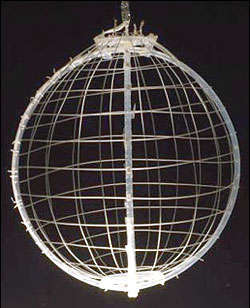
'Touching' with Light: Optic Sphere Senses Environs
CAMBRIDGE, Mass., July 7, 2006 -- A sophisticated, lens-free optical system has been developed from a sphere of photodetecting fibers that can "sense" the optical properties of the surrounding space, detect the source of incoming light and has an unlimited field of view. The system's creators said it may ultimately be used in applications ranging from improving space telescopes to providing the visually impaired with clothing that can "sense" its environs.
In what they said is a radical departure from conventional lens-based optics, Massachusetts Institute of Technology scientists developed the new optical system out of mesh-like webs of light-detecting fibers. The fiber constructs, which have a number of advantages over their lens-based predecessors, are currently capable of measuring the direction, intensity and phase of light without the lenses, filters or detector arrays that are the classic elements of optical systems such as eyes or cameras, the researchers said.
A sphere-shaped web of photodetecting fibers developed by MIT scientists can sense the optical properties of the entire volume of space around it, as well as detect the source of incoming light. (Image: Greg Hren)
The transparent fiber-webs could even enable huge computer screens to be activated with beams of light instead of the touch of a finger. "We could use light to enhance interaction with computers and even gaming systems," said team leader and MIT professor Yoel Fink of the department of materials science and engineering (MSE) and the Research Lab of Electronics (RLE). "It's intriguing -- the idea of touching with light."
The human eye, digital and film cameras, and space telescopes rely on lenses and detector surfaces (like the retina) to create images. But while these systems deliver excellent images, they are constrained by their size, weight, fragility and limited field of view. In contrast, Fink said, the fiber webs are flexible and lightweight. Plus, a fiber web in the shape of a sphere can sense the entire volume of space around it, he said.
"When you're looking at something with your eyes, there's a particular direction you're looking in," says Ayman Abouraddy, a researcher in Fink's lab and a team member. "The field of view is defined around that direction. Depending on the lens, you may be able to capture a certain field of view around that direction, but that's it. Until now, most every optical system was limited by an optical axis or direction."
In addition to having an unlimited field of view, the fiber sphere can also detect the direction of incoming light, he said. Light enters the transparent sphere at one point and exits at another, providing a directional reference back to the light source.
Fink's team has also created a flat, two-dimensional web of fibers and placed two of them in parallel. These constructs, which can measure the intensity of incoming light, are capable of generating rough images of objects placed near them, such as the shape of a letter "E" cut stencil-like from paper and lit from behind. The image shows up on a computer screen, reconstructed from a light intensity distribution measured by the webs. The fibers used in the webs are about 1 mm in diameter. They consist of a photoconductive glass core with metal electrodes that run along the length of the core, all surrounded by a transparent polymer insulator.
The fibers can detect light anywhere along their length, producing a change in current in an external electrical circuit. While one fiber on its own cannot detect the exact location of an incoming beam of light, when many fibers are arrayed in a web, their points of intersection provide the exact coordinates of the beam. A computer assimilates the data generated by the web and translates it for the user. If the fibers were woven into a textile, for instance, an embedded computer could provide information on a small display screen or even audibly.
Improving the imaging power of the fiber webs will require reducing the diameter of the fibers and creating denser webs. Fink said he's not certain whether the new technology will one day replicate human vision, but "just the idea of imaging with a transparent object is a true eye-opener," he said.
In addition to Abouraddy, Fink's colleagues on the work are John Joannopoulos of RLE (MIT's Francis Wright Davis Professor of Physics), RLE research scientist Mehmet Bayindir (now a faculty member at Bilkent University in Turkey), graduate students Ofer Shapira of the department of electrical engineering and computer science and Fabien Sorin of MSE, RLE research assistant Jerimy Arnold and Dursen Hinczewski (now at Istanbul Technical University in Turkey). Yigal Migdal assembled the sphere.
The work is funded by the MIT Institute for Soldier Nanotechnologies, the US Department of Energy, DARPA and the National Science Foundation. The scientists reported the work in the June 25 online edition of Nature Materials, and it is featured on the cover of the magazine's July print issue. For more information, visit: www.mit.edu
/Buyers_Guide/American_Air_Water_Inc/c657